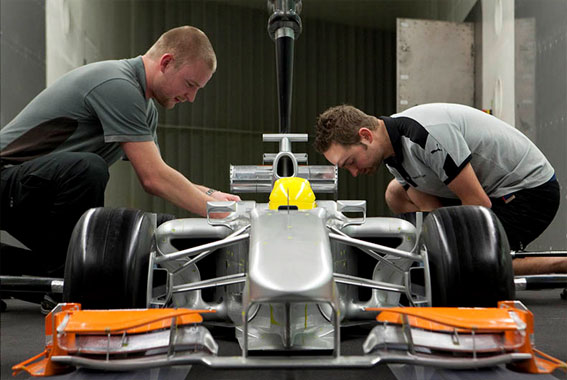But a VTT sim is as relevant to aero as it is to engines.
I mean, possibly even more so when you consider that aero upgrades and packages occur 20 times in a season these days.
Whereas engines remain constant until the next token package arrives, which could be 6 races into a season.
Be that as it may, I see where you are getting here.
Simulation tech dont come cheap, especially on the finer scale. I'll quote some or other geezer on Mercedes $160 million sim in Sindelfingen.
JohnsonsEvilTwin wrote:Here's a copy of the Mercedes GP sim.
This one is based in Sindelfingen, Germany. But Brackely has a copy of this same simulator.

With its 360° screen, fast electric power system and a twelve-metre long rail for transverse movements, the dynamic simulator is the most advanced in the automobile industry. As an equally advanced feature, part of the energy required to drive the simulator is obtained by means of energy recuperation when braking, and fed into the power network of the Sindelfingen plant.
I also stumbled across an interesting link which shows the scale of an F1 operation. 40 man hours to paint a single front wing....
http://www.idgconnect.com/blog-abstract ... or-sensors
Then we get into the Qualcomm/Mercedes collaboration which gets Mercedes data near instantaneously, from car to pit, and probably back to the sims in Brackley.
Yoda wrote:The real challenge that we had was around tyre data
One of the key things here is that you have a big surface there and you want to see the temperature on all four tyres.
That requires effectively a video of telemetric data, rather than single channels from single sensors. The bulk of data you then need is suddenly in a whole different order of magnitude.
We didn’t have the infrastructure to bring that off the car quickly. So what we developed with Qualcomm was a WiFi solution that allowed us to actually gather that data back into our system before the car had actually stopped, whereas previously we had to download it afterwards.
And it also might have taken us twenty minutes to half an hour because it was so bulky, effectively video-scaled data.”
Qualcomms Davison wrote:"I think we’ve got a little more breathing space on the current system, but we are already looking at, and we talked about this a number of times now with the Mercedes guys, moving from the 5 gigahertz 802.11ac system to the 60 gig 802.11ad system.This system was designed for use in buildings. It’s short ranged but it has a very, very wide bandwidth.
So we are now looking if we can put this system in an environment it wasn’t designed for, which allows us to rapidly understand how we can improve that technology so it can be used in an environment where there is the possibility of smog, moisture and rain, things that affect a 802.11ad because of its very high frequency.
So we can do things like compression on the car. This way we can reduce the amount of data that you need to physically dump off. So you can collect more and dump it off quicker. One of the interesting things we discovered was that our system was connecting early, At certain circuits, we actually connected with the car while it was going down the start-finish straight.
So we realized that the system, with some architectural changes, might actually be able to gather data in a very ad hoc burst mode, as the car goes through certain sections. So that’s an area we looked at."
http://www.motorsport.com/f1/news/analy ... 16-676175/
Mostly to your contribution Ben, I reckon we should add simulation to the "cheapest route to performance convergence"....









